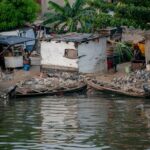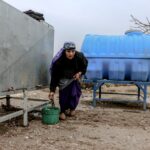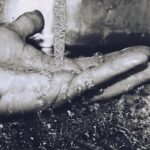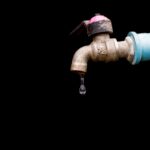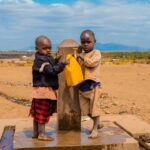Breaking Barriers to Clean Water Access
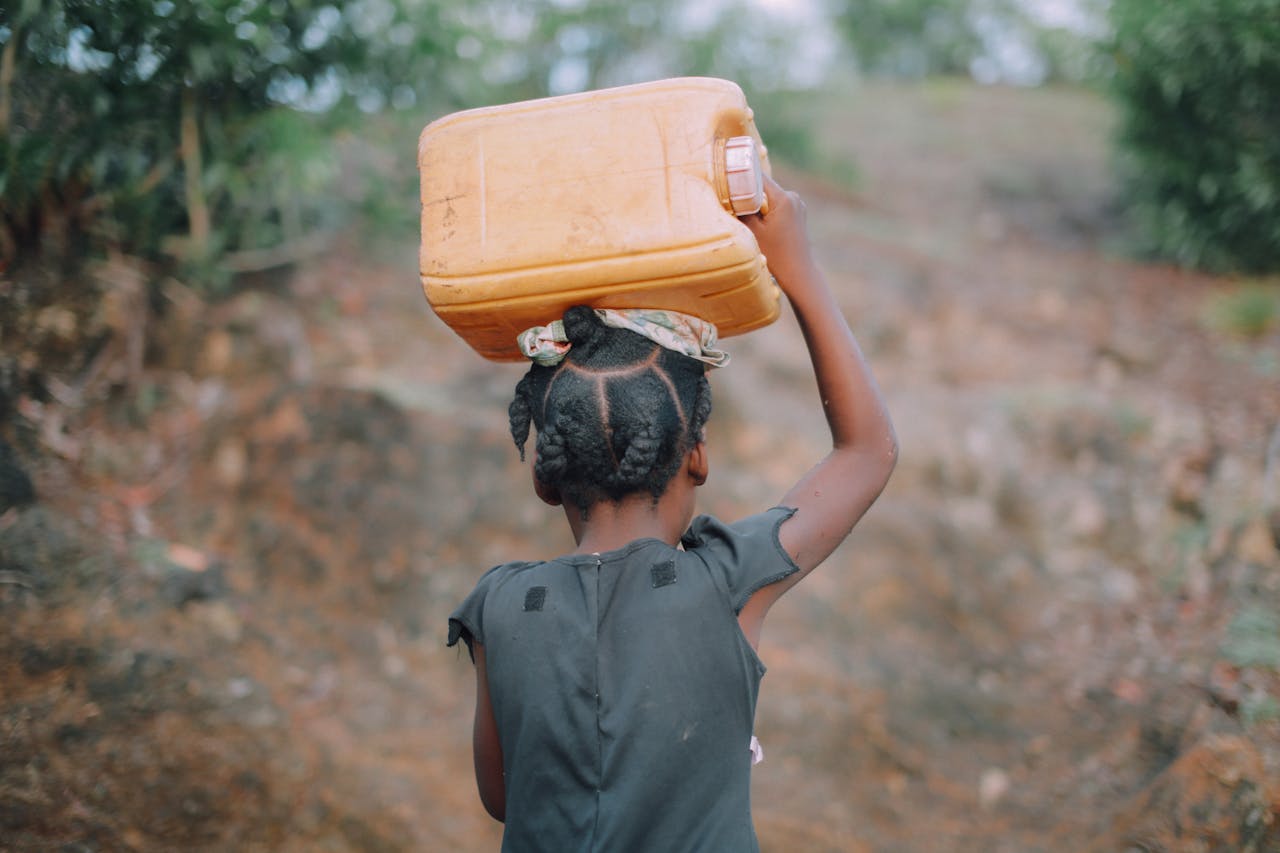
Tumi is a 12-year-old girl in a small village called Araromi Quarters in Ikole, Local Government Area of Ekiti State, Nigeria. Her morning chore of fetching water starts at barely daybreak. Her thin arms carry a a sizable jerrycan. After filling her jerrycan, she gets help to place it on her head and journeys back home as quickly as she can. The purpose? To fill as many empty barrels as possible. This wasn’t just a simple morning chore, but a difficult and necessary one. Each step Tumi took represented the unspoken burden carried by young girls – hours away from school, potential danger, and water that might not even be safe to drink. Tumi’s story is a powerful illustration of the challenges faced by girls across water scarce regions.
According to research, 71 million Nigerians do not have clean water. In rural areas, this number becomes even more glaring. Communities rely on unprotected wells, streams, and rainwater collection, with water sources frequently contaminated by agricultural runoff, industrial waste, and inadequate sanitation.
Water, Beyond Thirst
Water (preferably clean) undoubtedly quenches thirst, but there’s more to its usefulness: survival, dignity, and opportunity. Right now, 780 million individuals worldwide lack access to improved drinking water and 2.5 billion lack improved sanitation.
That’s still a huge chunk of the global population living without this fundamental human necessity, and this translates to major consequences such as increased child mortality, disrupted education, and economic strain.
The health implications are immediate and severe. Waterborne diseases like cholera, typhoid, and dysentery continue to challenge communities, particularly affecting children under five. Each cup of unclean water becomes a potential health risk.
The Barriers: A Complex Landscape
The obstacles to clean water access are multilayered and deeply rooted:
1. Infrastructure Challenges
Many regions lack the basic infrastructure to deliver clean water. Rural and remote communities are often completely disconnected from water treatment systems. Wells are rare, and existing water sources are frequently contaminated.
2. Economic Constraints
Building water infrastructure is expensive. Many developing countries simply don’t have the financial resources to invest in comprehensive water systems. International aid helps, but it’s not a complete solution.
3. Geographic Limitations
Some regions face extreme geographical challenges. Drought-prone areas, regions with difficult terrain, and places experiencing climate change impacts find water access increasingly difficult. Underground water sources might be scarce or hard to access.
4. Political and Social Barriers
Water, aside from being a technical problem, is a political one. Some regions suffer from governmental neglect, conflict, or systemic inequality that prevents water infrastructure development. Marginalized communities are often the last to receive water access investments.
These barriers aren’t mere talk – they represent real human experiences just like Tumi’s story, like other children like her missing school, like families fighting preventable illnesses.
Innovative Solutions: Bridging the Water Divide
Hope isn’t absent in the face of these challenges. Innovative approaches are emerging that promise to transform water access:
1. Community-Led Water Projects
Local communities are becoming their own solution architects. Grassroots initiatives are training community members in water system maintenance, well drilling, and water purification techniques. These projects don’t just provide water – they build local capacity and create sustainable infrastructure.
2. Technological Breakthroughs
Simple yet revolutionary technologies are changing water access. Portable water filters that can remove 99.9% of bacteria, solar-powered water purification systems, and low-cost desalination technologies are creating new possibilities.
3. Low-Cost Filtration Methods
Innovations like biosand filters, ceramic water filters, and solar disinfection methods are providing affordable water treatment options. These solutions use locally available materials and can be implemented with minimal technical expertise.
What Individuals Can Do
We all agree water access is a global challenge, but it is also a personal opportunity for impact:
1. Support Effective Organizations
Targeted donations to nonprofit organizations like Aqua Maya and others can make a direct difference. These organizations focus on sustainable water infrastructure and community empowerment.
2. Raise Awareness
Social media, community discussions, and educational initiatives can amplify the conversation about water access. Every conversation is a potential catalyst for change.
3. Personal Lifestyle Choices
Conscious water consumption, supporting water-conscious businesses, and advocating for water conservation in local communities can contribute to broader water sustainability efforts.
4. Education and Advocacy
Learning about water challenges, supporting educational programs that highlight water access issues, and engaging with local and global policy discussions can create systemic change.
The story of water access is ultimately a story of human potential. For every challenge, there’s an opportunity for collective action, innovation, and hope.
Health Implications
Water scarcity isn’t just an infrastructure problem – it’s a critical health emergency. Contaminated water sources directly impact community health, creating a cycle of illness and economic strain. Children are the most vulnerable, with waterborne diseases causing significant child mortality rates.
In rural communities like Tumi’s, each water source becomes a potential health risk. Diarrheal diseases, which are largely preventable with clean water, remain a leading cause of child mortality in Nigeria. The World Health Organization estimates that 829,000 people die annually from diseases directly caused by unsafe drinking water, inadequate sanitation, and poor hygiene practices.
Women and Girls: The Disproportionate Water Burden
The water crisis has a gender dimension that cannot be ignored. Girls like Tumi bear the primary responsibility for water collection in many communities. This daily task has dire consequences:
1. Educational Disruption
Hours spent collecting water mean less time in school. Many girls miss classes or drop out entirely due to water collection responsibilities. This creates a generational cycle of reduced opportunities and economic disadvantage.
2. Safety Risks
Long water collection journeys expose girls to multiple dangers, including potential sexual violence, physical exhaustion, and risk of accidents. The simple act of bringing water home becomes a daily navigation of risk and survival.
3. Economic and Social Impact
Water access is a fundamental economic issue. Communities without reliable water sources face significant economic challenges.
4. Productivity Loss
Time spent collecting water is time not spent on education, work, or economic development. In rural Nigerian communities, this can mean losing hundreds of productive hours annually.
5. Agricultural Challenges
Water scarcity impacts agricultural productivity. Small-scale farmers struggle to maintain crops, creating food insecurity and economic instability.
6. Healthcare Economic Burden
Waterborne diseases create additional economic strain. Medical treatments, lost work days, and ongoing health challenges create a cycle of economic vulnerability.
Climate Change and Water Scarcity
Climate change is dramatically reshaping water access globally. Rising temperatures, irregular rainfall patterns, and increased frequency of extreme weather events are pushing water resources to their limits. Drought periods are becoming longer, groundwater levels are depleting, and traditional water sources are becoming less reliable.
In agricultural communities, this means crop failures, reduced food security, and increased economic vulnerability. The interconnection between climate change and water access creates a complex challenge that requires innovative, adaptive solutions.
Technological Innovations in Water Management
Emerging technologies are offering new hope for water-scarce communities. Satellite mapping technologies now help identify underground water sources. Drone-based water quality monitoring systems can detect contamination quickly. Mobile applications are being developed to track water point functionality and maintenance needs. Smart water management systems that use IoT (Internet of Things) sensors to monitor water quality, usage, and infrastructure health in real-time are becoming the order of the day. These technologies promise more efficient, responsive water resource management.
Policy and Governance: The Critical Infrastructure Challenge
Water access is fundamentally a governance issue. In Nigeria, for instance, water management involves complex interactions between federal, state, and local government bodies. Despite national policies like the National Water Resources Master Plan, implementation remains inconsistent.
Local governments often face significant challenges in water infrastructure development. Limited budgets, competing priorities, and complex bureaucratic processes often delay critical water projects. Effective water access requires not just technical solutions, but robust, transparent, and community-centered governance approaches.
Key policy challenges include:
• Fragmented water resource management
• Insufficient funding for infrastructure
• Weak monitoring and maintenance systems
• Limited community participation in water governance
Conclusion
Tumi’s story is more than a single narrative – it’s a mirror reflecting the experiences of millions. Her daily water journey represents a global challenge that demands more than sympathy. It requires action, innovation, and a fundamental reimagining of how we value water.
The water crisis isn’t a distant problem – it’s happening now in communities like Araromi Quarters, Ikole Local Government Area, and in countless villages across Nigeria and the world. Each water collection journey represents lost educational opportunities, health risks, and economic constraints.
But hope isn’t passive. Hope is active. Hope is the community leader training local water technicians, and the engineer designing affordable filtration systems. Hope is the policymaker pushing for infrastructure investment. Hope is you – reading this, understanding, and deciding to make a difference.
We stand at a critical intersection. Climate change, population growth, and economic inequalities are converging to make water access more challenging. But we also stand at the cusp of unprecedented technological and social innovations that can transform this challenge.
Clean water is not a privilege. It’s a fundamental human right. It’s the difference between survival and opportunity. It’s the foundation of health, education, and economic dignity.
For Tumi, and for millions like her, our collective action can turn the tide. Every conversation, every donation, and every advocacy effort matters. Water is life – and together, we can ensure that life flows freely.
The journey of a thousand miles begins with a single step. Our step begins here: now. See what Aqua Maya is doing here and become a part of it.
Sources
1. https://www.un.org/en/global-issues/water
3. https://www.unicef.org/serbia/en/impact-of-climate-change-on-water-availability-and-quality
4. https://pmc.ncbi.nlm.nih.gov/articles/PMC7172419/
6. https://www.un.org/en/climatechange/science/climate-issues/water
7. https://www.undp.org/nature/our-work-areas/water-governance

